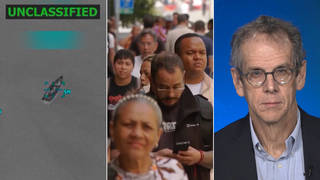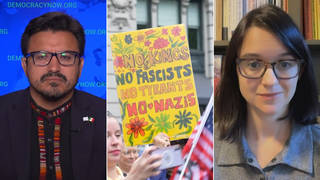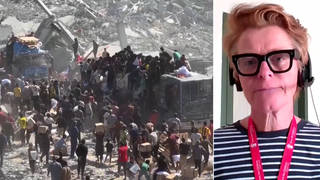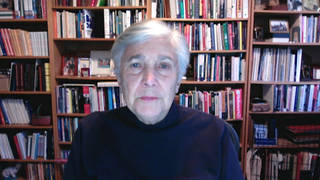
Topics
Guests
- Azam Ahmedreporter for the Chicago Tribune. His latest story is How VIPs Lobbied Schools
- Pauline Lipmanprofessor of education and policy studies at the University of Illinois-Chicago. She is also the director of the Collaborative for Equity and Justice in Education at the university and is on the coordinating committee for Teachers for Social Justice.
- Jitu Browncommunity and educational organizer with the Kenwood Oakland Community Organization. He teaches at St. Leonard Adult High School for the formerly incarcerated.
When President Obama’s Education Secretary, Arne Duncan, was the head of Chicago’s Public Schools, his office kept a list of powerful, well-connected people who asked for help getting certain children into the city’s best public schools. The list — long kept confidential — was disclosed this week by the Chicago Tribune. We speak with the Chicago Tribune reporter who broke the story and with two Chicago organizers about Duncan and his aggressive plan to expand charter schools. [includes rush transcript]
Transcript
JUAN GONZALEZ: When President Obama’s Education Secretary, Arne Duncan, was the head of Chicago’s Public Schools, his office kept a list of powerful, well-connected people who asked for help getting certain children into the city’s best public schools. The list — long held confidential — was disclosed this week by the Chicago Tribune.
The paper reports that the nearly forty pages of logs show admissions requests from twenty-five aldermen, Mayor Daley’s office, the state House Speaker, the state attorney general, the former White House social secretary, and a former United States senator. The log noted “AD” — initials for Arne Duncan —- as the person requesting help for ten students and a co-requestor about forty times.
A spokesman for Duncan denied any wrongdoing and said Duncan used the list, not to dole out rewards to insiders, but to shield principals from political interference.
AMY GOODMAN: Duncan was chief executive of the Chicago schools, the nation’s third-largest school system, from 2001 to 2009. During that time, he oversaw implementation of a program known as Renaissance 2010. The program’s aim was to close sixty schools and replace them with more than 100 charter schools. Now as President Obama’s Education Secretary, Duncan is overseeing a push by the administration to aggressively expand charter schools across the country.
For more, we go to Chicago. We’re joined by Azam Ahmed, the reporter for the Chicago Tribune who broke this —-20100322,0,5656688.story”>latest story about the so-called VIP list of requests, and Pauline Lipman, professor of education and policy studies at the University of Illinois-Chicago. She’s also director of the Collaborative for Equity and Justice in Education at the university, is on the coordinating committee for Teachers for Social Justice.
We welcome you both to Democracy Now! I want to go first to Azam Ahmed. Congratulations on this exposé. I’m calling it the A-plus list, I guess, the “A” list, what you’re saying is the VIP list. Explain exactly how it worked.
AZAM AHMED: Well, Secretary Duncan had asked one of his staff members to keep a list of people who called his office on behalf of a student. So, in addition to VIPs, there were parents, siblings, folks who just happened to call Arne Duncan’s office to request that their child be considered or their sibling be considered for a selective school. But it’s noted very — it’s a very specifically spreadsheet: the date that there was a request, the name of the student, the name of the parent, their top three choices of schools, who exactly was requesting. And then there was a field for notes, a field to determine what exactly happened with the candidate, and the more explanatory dates.
JUAN GONZALEZ: And what happened to that list after it was compiled?
AZAM AHMED: It was maintained, and each individual case — and in this case, every case, whether it was a VIP or a parent, every case was followed up on, and some sort of resolution was reached. From the logs that we obtained, some of that is — it’s very clear in some cases — in other cases, it’s unclear — what the final status ended up being of the individual student.
AMY GOODMAN: Talk about —-
AZAM AHMED: And it was kept up until this year.
AMY GOODMAN: How did you get a hold of this list, Azam?
AZAM AHMED: There had long been rumors about such a list existing or there being some kind of a way to maybe lobby to get your kid into a school. It was never clear there was a list. But I began casting out to different sources, asking them, and, you know, it was -— it was a little bit of luck, I think.
JUAN GONZALEZ: But other than them collecting the list, was there any indication that then there was actual efforts made with the various principals who were in charge of these schools to get these kids admitted?
AZAM AHMED: The central office would call the principals and ask. They’ve been unequivocal about saying they never pressured anybody to accept a student. And a few principals I’ve talked to have also said they never — they were never pressured. It was a “Hey, we have this kid. We’ve checked out his background, pretty good scores” — or whatever the case may be — “Do you a space for them?” Oftentimes on the list you’ll see they — a student might have applied to the top one or two schools in the district and their testing scores just simply weren’t high enough, and often those kids would be put in a still desirable, but not as competitive, school. So, oftentimes kids would get placed maybe not in their first one or two choices, but they would find somewhere better than perhaps their neighborhood school.
AMY GOODMAN: You talk about the case of former Senator Carol Moseley Braun weighing in for a student to get in. Explain that story and who actually kept this list.
AZAM AHMED: One of Duncan’s top aides, David Pickens, was asked by Duncan to keep the list. And in this case, our understanding of it is Carol Moseley Braun was trying to get a certain student into Whitney Young, which is a very high-performing school in the city. She was getting no response from the principal. She called David Pickens, who then asked the principal to call her back. And then, whatever happened there was between the principal and Carol Moseley Braun. But ultimately, one of the two students Carol Moseley Braun was interested in having placed at Whitney Young did indeed get placed at Whitney Young.
JUAN GONZALEZ: We’re also joined by Pauline Lipman, professor of education and policy studies at the University of Illinois-Chicago. Could you talk about the significance of this list and also the battle of parents in Chicago to get into these elite schools in the city?
PAULINE LIPMAN: Yes, good morning. I’m really glad that Azam has done this story, because it provides some evidence for what we’ve pretty much known on the ground all along. And as you said, I think that what it reveals is a bigger scandal.
The larger scandal is that Chicago has basically a two-tiered education system, with a handful of these selective enrollment magnet schools, or boutique schools, that have been set up under Renaissance 2010 in gentrifying and affluent neighborhoods, and then many disinvested neighborhood schools. So parents across the city are scrambling to try to get their kids into a few of these schools. So instead of creating quality schools in every neighborhood, what CPS has done is created this two-tier system and actually is closing down, as you said, neighborhood schools under Renaissance 2010 and replacing them with charter schools and a privatized education system, firing or laying off, I should say, certified teachers, dismantling locally elected school councils, and creating a market of public education in Chicago, turning schools over to private turnaround operators. And this is, in the bigger, bigger scandal, this is now the national agenda under the Obama administration for education.
JUAN GONZALEZ: And amazingly, Arne Duncan doesn’t have that much of a — he’s not an educator by trade, to speak of. Could you talk a little bit about his background?
PAULINE LIPMAN: Yeah, not only is he not an educator by trade, I mean, he was a functionary in the Daley administration. But because Chicago is under mayoral control of schools, which is another part of Obama’s and Duncan’s national agenda under the federal stimulus Race to the Top funds, because of that, what we have is exactly a school system that is led at the top by virtually no educators. There is only one educator in a high position. The board are all appointed by Daley. They are all bankers or corporate heads. The CEO of schools before Duncan, Paul Vallas, was in Daley’s budget office. The new CEO, Ron Huberman, ran the Chicago Transit Authority. So we have a school system that, as a whole, is led by corporate managers, not by educators.
And in fact, that’s revealed in the fact that there’s basically no research that supports any of the interventions that they’ve made under Renaissance 2010. And there’s a good deal of research that demonstrates that it has been damaging to students and to communities and has not improved their education.
AMY GOODMAN: We’re talking to Professor Pauline Lipman. She teaches education and policy studies at the University of Illinois-Chicago. Arne Duncan said Katrina, you know, the hurricane, may have been the best thing to happen to New Orleans when it comes to education. How do you see what’s going on right now in Chicago playing out on the national scape with Arne Duncan, head of education in Chicago, now become the Education Secretary?
PAULINE LIPMAN: Well, I think that that’s a really good question, because I think probably the best phrase to describe what is happening nationally is what Naomi Klein calls “disaster capitalism.” So we have a situation in which there’s a fiscal crisis in the cities and in the states. We have a situation in which we have a long history disinvested public schools in communities of color. And in that context, there is now a move to privatize public education, just as happened in New Orleans, which was devastated by Hurricane Katrina, and then that was seen as an opportunity to actually move in and privatize public schools.
So the federal stimulus money that’s being offered now to the states is being offered on the condition that they raise charter school caps, that they tie teacher evaluations to students’ test scores, that they close what they call failing schools, that they turn them over to private turnaround operators. So we have a neoliberal project nationally, which was tested out in Chicago and then is now being pushed out nationally.
And one of the ways that this was dramatized so clearly to me was that almost immediately after Arne Duncan was selected to be Secretary of Education, he flew to Detroit, which is one of the most disinvested, economically devastated cities in the country. And it was — their school system has been decimated because of the economic crisis in Detroit. And he offered millions of dollars, but on the condition that they would do the Chicago plan.
AMY GOODMAN: I want to say that we also will be broadcasting from Detroit next week, April 2nd, and for a week in June for the US Social Forum that’s taking place there. Juan?
JUAN GONZALEZ: Well, we’re also joined by Jitu Brown, who’s a community and educational organizer with the Kenwood Oakland Community Organization. He teaches at St. Leonard Adult High School for the formerly incarcerated. Jitu Brown, I’d like to ask you, because here in New York City, there are huge battles now developing between public school parents, as the city closes more public schools and opens more charter schools or co-locates charter schools inside existing neighborhood public schools. In many neighborhoods, there are huge battles. I’d like to ask you, what happened in Chicago as Arne Duncan rolled out his Renaissance 2010? And what was the impact at the community level of this educational reform?
JITU BROWN: Yes, sir. Well, I would like to say the first thing, first thing off, that our community, which is the Mid-South area, the South Side of Chicago, from the lake — close to the lakefront, maybe ten minutes from downtown, has really experienced school closings since maybe 1997, very quietly, and because of the CHA Plan for Transformation. So as public housing units were torn down, schools were closed, and young people were moved from place to place.
In 2004, we received a phone call from a parent by the name of Brenda Norwood from Doolittle West Elementary School on the last day of school, complaining that she just found out that her child’s school was going to close. And we began to get several phone calls like that. So, consequently, we organized an initial town hall meeting, where maybe 300 people came out. And we decided to put pressure on our local alderman to find out what was the plan. We had heard inklings of a Mid-South plan, but we hadn’t seen it.
So, after a couple of actions where we took maybe forty or fifty local school council members to a meeting sponsored by the alderman, she gave us the plan, which was the Mid-South plan, where we saw there was a plan to close twenty out of the twenty-two schools in our neighborhood over a three-year period and transform them into either charter, contract, or what they were calling at that time small schools, which are really CPS performance schools. That’s around the time that me and Pauline first met each other. And we began to work together and really look to build coalition around resisting these school closings.
So, the impact was disastrous. It was students going to as many as three schools over a five-year period. There were — even in the early stages of this, there were violence spiking in several schools in our neighborhood. So, for example, Fuller Elementary School, which had become a CPS Rising Star school, being a receiving school when Raymond School closed, and then the violence at Fuller spiking and just destroying the school atmosphere. So I think that the impact really harmed education in our neighborhoods. And then you saw it throughout the entire city, because as this rolled out, schools were being closed on the West Side in North Lawndale. Schools were being closed on the Far South Side.
But due to the work of, again, our community-based organizations, powerful groups like Teachers for Social Justice, and also labor, working with SEIU Local 1, and, to some extent, the CTU, Chicago Teachers Union, we were able to push to get the school closing policy changed, where they could no longer focus on one geographic area, and they had to provide some notice to parents, and so — along with having the Mid-South plan become shelved, where they had to, you know, find another way to do it. But they knew that they couldn’t just directly come in our neighborhood and shut down schools. So, it had a horrible effect.
AMY GOODMAN: Jitu, I wanted to ask you about the militarization of the schools in Chicago. Perhaps in Chicago they’re the most militarized in the country. Five public schools have been turned into military academies. I think there are 10,000 students in uniform, over three dozen junior ROTC programs in Chicago’s high schools. Duncan said, in 2007, “I love the sense of leadership. I love the sense of discipline.”
JITU BROWN: Mm-hmm, mm-hmm. Well, to us, it’s an indictment, because, one, many of our young people, after being underserved by the public school system, end up going to the military because they feel they have no other choice, because the quality of their education hasn’t really prepared them to go on to college, or they don’t have the resources. So they look to the military as a last resort. I experience this every day, try to talk young people out of it.
But one of the major issues is that they are throwing millions of dollars of resources into militarizing our schools and not putting those same resources into making public schools better, because there are examples of regular public schools in Chicago that serve low-income African American and Latino youth that are good schools. Beethoven is a good example on the South Side. This is a school that’s right now at about 80 percent of students reading at or above reading level. And we don’t want to just go on test scores, but if that’s the indicator, they have strong community involvement. So we feel like the priority is not to make sure that our young people have the opportunity to do better than their parents, but that the intent is to prepare young people for the armed services. And so, that’s an issue for us.
AMY GOODMAN: And your school, can you explain — it’s highly unusual. A school for the formerly incarcerated, a high school?
JITU BROWN: OK, yes, ma’am. It’s called St. Leonard’s Adult High School. It was actually started by some — I will call them revolutionary nuns at St. Leonard’s House, in partnership with faculty from Northeastern Illinois University and DePaul University. And it is an accredited high school that provides adults who have been formerly incarcerated with the opportunity to get their high school diploma, also with job — excellent job placement services. And we have a relationship right now with the City Colleges of Chicago, where several of our graduates go on to college. And then, of course, they have the counseling services to aid those men and women in their transition. It’s a fifteen-week program, very rigorous. And proud I’ve been a part of it for maybe eight years. I teach African American history there.
JUAN GONZALEZ: I’d like to ask Pauline Lipman about the overall effort in Renaissance 2010 and now in Arne Duncan’s attempts to take it nationwide, the impact on the neighborhood public school, well, a public school that is not just a building with a bunch of students, but is an institution in the community where the parents know each other, where they all come from the same neighborhood. What is happening to that tradition of the neighborhood public school as an institution?
PAULINE LIPMAN: Yeah, thank you for asking that question, Juan, because I think that’s a very key part of what has happened. As Jitu was saying, we’ve seen a really devastating impact in many of the neighborhoods where the schools have been closed. The school is one of the central institutions in a neighborhood, a neighborhood that’s suffering — has been suffering from unemployment, economic devastation, the transformation of public housing. And so, we see that these schools become sort of the core of the neighborhood.
And we have examples; I can describe one. Anderson Elementary School in the West Town area of Chicago, with a primarily Latino and African American population, one of the schools that you could say was really a good neighborhood school. And that area has become extremely gentrified. As it was gentrified, many people had to move out. The people who were still remaining and even people who moved out continued to send their children to that school, because it did in fact represent and anchor the neighborhood. And there was a huge battle over that a year ago, in 2008, when under Renaissance 2010, despite massive protests on the part of the parents — pickets, demonstrations, research that they did, busing of people down to the school board to protest —- despite that, Chicago Public Schools closed it down, and they turned the school over to a school called LaSalle Language Academy, which is one of the most coveted, elite boutique schools in the city, for precisely the new, gentrifying, middle-class folks who had moved into that neighborhood.
So we’ve seen this happening again and again around the city. There is one ward on the West Side of the city where they no longer have a single public high school. Every high school is a charter high school. So what that means is that parents and students are looking not just in their neighborhood, but all around the city, to try to find a school to get their children into. It’s a market. They’re shopping for schools. And so, all the roles that those schools have historically played to provide support and continuity have been totally disrupted.
AMY GOODMAN: Pauline Lipman, we want to thank you very much for being with us, University of Illinois-Chicago. Jitu Brown, educational organizer with the Kenwood Oakland Community Organization, and Azam Ahmed of the Chicago Tribune. We’ll link to your —-20100322,0,5656688.story”>article at democracynow.org.












Media Options